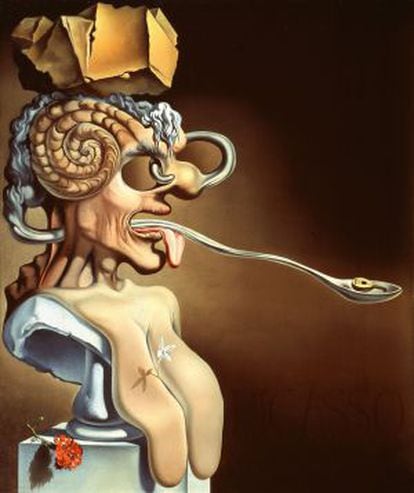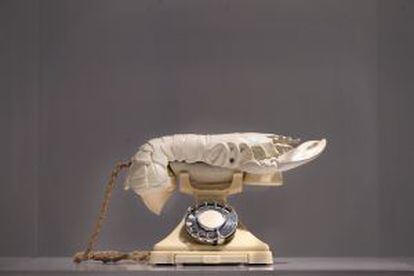Dalí the artist vs Dalí the performer
A major retrospective of the Spanish Surrealist master at Madrid's Reina Sofía is likely to be the exhibition of the year

In December 1965 Salvador Dalí, who by then was already enjoying global stardom, featured in several New York "manifestations." For the opening of the Gallery of Modern Art, a packed crowd watched him paint a horse rider in real time while the flamenco guitarist Manitas de Plata and the singer José Reyes performed soleares praising the Surrealist artist's genius. In another memorable performance, Dalí sipped from a swan's egg as a swarm of ants emerged from within. Both "manifestations" made up the core of Dalí in New York , a documentary by British filmmaker Jack Bond in which the Spanish artist showed his worst side as an artist but that brought out the best of his larger-than-life persona.
Standing before the cameras, Dalí rattled off all those phrases that have made him insufferable to so many people for so many years: "I only want slaves by my side;" "The monarchy is the best form of government because kings like myself are elected by God;" "The Holy Inquisition should be brought back;" and more. A narcissistic egomaniac, a master of performance, a genius at advertising ("I am very busy being Dalí and I can only see people for symbolic reasons like money or publicity," he said in a 1955 interview), Dalí has always been imitated, then as now, by other artists, including Andy Warhol, Damien Hirst and Jeff Koons.
But Salvador Dalí the artist is a very superior figure to Dalí the incommensurate performer. He occupies a top spot in art history, and stressing this point is the challenge that lies ahead.
Todas las sugestiones poéticas y todas las posibilidades plásticas, is a new show that opens on Saturday at Madrid's Reina Sofía. This major retrospective, which includes more than 200 artworks, was previously on display at the Centre Pompidou in Paris, where it was seen by 790,090 people in four months. Without a doubt, it will be the exhibition of the year in Spain.
The Madrid version is being curated by Montse Aguer, director of the Dalí Study Center at the Fundación Gala-Salvador Dalí in Figueres, and one of the people who was closest to the artist during the last years of his life. Aguer feels that the time has come for an unprejudiced approach to this dual Dalí - the character and the artist. To achieve this, organizers have secured art loans from major institutions, private collections and the three main repositories of Dalí's art: The Fundación Gala-Salvador Dalí, the Salvador Dalí Museum in St. Petersburg (Florida) and the Reina Sofía museum in Madrid - this latter center has around 50 major Dalí artworks among its permanent holdings.
Thirty of the items that will go on display on Saturday have never been seen in Spain before, including the very salient The persistence of memory (the famous soft watches) and El Ángelus de Gala, which have been loaned by New York's MoMA; Metamorphosis of Narcissus, usually seen at Tate London; The Temptation of Saint Anthony, kept by the Musées Royaux des Beaux-Arts in Belgium; Partial Hallucination: Six Apparitions of Lenin on a Piano, property of the Centre Pompidou; The Bathers and Geopoliticus Child Watching the Birth of the New Man, from the Salvador Dalí Museum in St. Petersburg, and Aphrodisiac Dinner Jacket, part of the private collection of the Greek mogul George Economou.
Dalí rattled off the phrases that made him insufferable to so many people
Manuel Borja-Villell, the director of the Reina Sofía, has a personal interest in Dalí - so much so that his doctoral dissertation versed on him and Antoni Tàpies. As such, he is certain that this exhibition was completely necessary because it has been over 30 years since the last major Dalí retrospective was held in Spain. The museum director feels that the younger generations do not know this artist sufficiently in-depth.
"The time has come to unveil the importance of his pictorial intelligence, to reveal an artist who has been partly concealed by his overwhelming persona and partly by rejection of his relationship with the Franco dictatorship," says Borja-Villel. "There are artists who could simply not stand him, and that is hard to change."
"He was a constant creator of images," adds Borja-Villell. "He participated in all the movements and was a forerunner of everything. He had a complete command of painting from an early age, just like Picasso, who was one of his obsessions. And like Duchamp, he understood the importance of serial work and the role of the artist. He was a real trailblazer in that sense, because later we saw artists such as Koons, who continue to do the same thing as Dalí, but without the content."
In order to highlight that authentic Dalinian essence, the exhibition follows a historical order that is punctuated by poetic moments. Divided into 11 sections, the show begins with a room devoted to self-portraits. There are six pictures painted on a variety of materials, including a Dalí figure with the face of Marilyn Monroe and hints of Mao Tse-tung. These were the learning years, when he also used his close relatives as models: his sister Ana María or his father, the notary of the town of Cadaqués. Work from this period already referenced one of Dalí's torments: having been baptized with the same name as his older brother, who died at age three. This fact altered Dalí's personality as a child. This first section also screens one of the most interesting videos (out of around a dozen) in the show, because of the information it provides on Dalí's character. Autoportrait mou de Salvador Dalí (Bland self-portrait of Salvador Dalí), made in 1966 by Jean-Cristophe Averty, features a very entertaining dissertation on the importance of wigs, among many other things.
Dalí's ties to the literary group known as "Generación del '27" and his youthful years at the influential Madrid student residence Residencia de Estudiantes, where he joined forces with Federico García Lorca and Luis Buñuel, are examined in the next section of the show. Surrealism, a movement that he was kicked out of by André Breton - whom Dalí compared with his father because of his authoritarian style - is the artist's most well-represented period. His famous paranoid-critical method allowed him to revolutionize the movement and create artworks like The Great Masturbator (1929), The Persistence of Memory (1931), William Tell (1930) and The specter of sex-appeal (1934). These paintings play with dual images or invisible images, depending on the standpoint of the viewer; this method gets museumgoers to become a part of the painting.

Dalí's sexual ghosts are made explicit in a section devoted to Millet's The Angelus, a famous 19th-century painting that provided fodder for Dalí's imagination. In his interpretation of this peasant couple praying in a field of newly sown potatoes, the woman figure is a praying mantis ready to eat the male after sex, while the masculine figure needs to protect his genitals to prevent them from being devoured.
Although his frivolous image conceals it, world conflicts and their effects were very much present throughout Dalí's work, and this is underscored in a section about war and Surrealism after 1936. This was the period that produced the unsettling oil paintings Premonition of the Civil War (1936) or The face of war (1940), in which Dalí resorts to depictions of cannibalism to express his displeasure.
World War II marked Dalí's American adventure, though not in New York - not at first. He and Gala, his longtime muse, settled down in Miami and shed any remaining vestiges of romanticism. Dalí grew as a performer of his own character, and partnered in film projects with Walt Disney and Alfred Hitchcock (a video in the show offers fragments of Spellbound, the 1945 Hitchcock movie that captured the Freudian-Dalinian universe on the big screen). Dalí wrote screenplays, designed movie sets and wardrobes, and began to show signs that he was no longer fully in control of his public appearances.
Beginning in the 1960s, his creative interest turned to science and new technologies. He made holograms and stereoscopic images, and featured in happenings and performances that were filmed by the greatest possible number of television stations. The exhibition ends with Swallow Tail and Cellos (1983), a piece that reflects his last obsession: the mathematical theories of René Thom, the last piece of evidence that Dalí's quest for fame was not incompatible with an interest for the major concerns of his time.
Dalí. Todas las sugestiones poéticas y todas las posibilidades plásticas . Until September 2 at Museo Nacional Centro de Arte Reina Sofía, c/Santa Isabel 52, Madrid. www.museoreinasofia.es










































